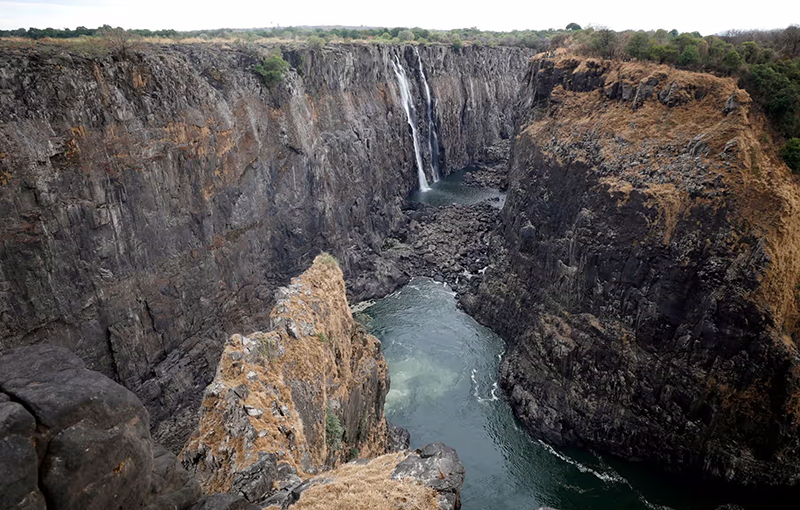- Featured
- No Comment
The Zambezi River is drying up, leaving millions without electricity

The Zambezi River, the fourth longest in Africa, serves as the lifeblood for millions of inhabitants on the continent and is a key energy resource. However, it is now on the brink of an ecological disaster.
The ongoing drought threatens both ecosystems and the people who have relied on its resources for generations. Agriculture, fishing, industry, and the supply of drinking water to hundreds of towns along the river’s course are in serious danger, and the effects of this phenomenon are impacting the economic and social stability of Zambia and Zimbabwe.
The effects on hydropower plants
One of the most severe consequences of the Zambezi River drying up is the impact of insufficient water on the hydroelectric infrastructure, which most of the region depends on. Kariba, one of the world’s largest artificial lakes, with a surface area of 5,580 km², once a symbol of development and energy stability, is now falling victim to extreme weather conditions.
Kariba, built in the 1950s as a result of damming the Zambezi, has powered hydroelectric plants on the Zambia-Zimbabwe border for decades. The combined installed capacity of the turbines is 2,010 MW, of which 960 MW is for Zambia and 1,050 MW for Zimbabwe. However, due to prolonged drought, the water level in the reservoir has reached a record low, severely limiting energy production.
Currently, the 128-meter dam wall is almost fully exposed, and only one of the six available turbines at Kariba is operational. According to a report dated October 15, 2024, the water level was 476.3 meters, which corresponded to just 5.56% of usable storage.
This marks a significant drop compared to 2023, when the water level on the same day was 2 meters higher, with 20.23% of usable storage. Such a steep decline results in severe limitations on power production, causing cities and villages to increasingly experience power outages, sometimes lasting for several consecutive days.

Crisis in Zambia and Zimbabwe
The consequences of the drought for Zambia and Zimbabwe are catastrophic. Power shortages are paralyzing daily life, and industrial, commercial, hospital, and school operations are increasingly disrupted. Industry, which largely depends on hydroelectric power, is struggling with sharply rising production costs, deepening the economic recession.
The energy crisis also has far-reaching social consequences, as the lack of electricity not only limits daily activities but also destabilizes the economy, increases unemployment, and fuels growing social discontent.
The drought hinders the irrigation of farmland, and declining agricultural production is driving up food prices, further deepening poverty. In March this year, Zambia declared a state of emergency. President Hakainde Hichilema announced that the water shortage had destroyed about 1 million out of 2.2 million hectares of maize, the region’s staple crop.
Worsening humanitarian crisis
The drought in the Zambezi region is not just an energy problem, but also an escalating humanitarian crisis. Water resources are dwindling rapidly, directly affecting the quality of life, especially for farmers and fishermen who have relied on the Zambezi River for generations.
Declining crop yields and falling fish catches are forcing the local population to seek alternative livelihoods. This often leads to migration to cities or other regions, which in turn causes social tensions and even greater poverty.
Water shortages are having a huge impact on sanitation and hygiene, which are deteriorating rapidly. Lack of access to clean drinking water, essential for maintaining basic hygiene, is contributing to the spread of diseases.
The lack of water, combined with malnutrition, increases the risk of epidemics. The drying up of many water wells, both in urban and rural areas, has led to a cholera outbreak across Zimbabwe. By mid-March 2024, more than 28,500 cases of cholera had been reported, with 589 deaths in all 10 provinces and 62 districts.

Seeking solutions to the energy crisis
Zambia’s energy sector is now focusing on urgent measures to mitigate the crisis’s effects. Possible solutions include accelerating investment in alternative energy sources and expanding the national power grid to make more effective use of regional resources.
The Zambian government has urged residents and businesses to use solar energy. Authorities have introduced tax breaks, such as the removal of customs duties and VAT on imported solar equipment, to facilitate the purchase of solar panels.
Additionally, they introduced a Net Metering program, allowing households to sell excess energy back to the national grid, encouraging citizens to use renewable energy. However, for many Zambians, the cost of this technology remains too high.
A similar problem has affected neighboring Zimbabwe, which has lost a significant portion of its electricity production from the Kariba Dam, leading to frequent power outages. However, a larger part of the country’s energy comes from coal-fired power plants, meaning the crisis is less severe and widespread.
